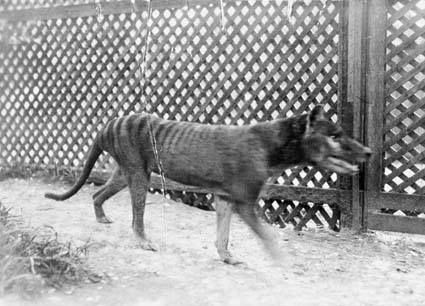This Thylacine Footage Was Recently Rediscovered By Researchers Gareth Linnard, Branden Holmes And Mike
This thylacine footage was recently rediscovered by researchers Gareth Linnard, Branden Holmes and Mike Williams on March 4, 2020.
Originally filmed by the Bester family c. 1933-1936, the 9.5mm black and white film includes 7 seconds of a captive thylacine in its enclosure at the Beaumaris Zoo.
Such a rare and amazing find!
More Posts from Moonlight-wolf-archive and Others
LOST THYLACINE FOOTAGE REDISCOVERED
Originally shot by Dr. Randle Stewart, an Australian psychiatrist, whilst on honeymoon in Tasmania, these 18 seconds of combined footage show the last captive thylacine in the world.
Commonly referred to as “Benjamin”, the individual lived at the now-abandoned Beaumaris Zoo from the early 1930s to his death in September of 1936, incidentally the same year thylacines were granted official protection by the Australian government.
The footage, shot in 1931, had been considered lost since the late 1970s.
There's a lot of angles of the skin we're missing
But I know a Thylacine's stripes are often compared to finger prints
(these are just observations)


1. Highlighted: branches of Benjamin's stripes where they connect to each other within the fur pattern.
Most are connected visibly on the photograph, while the skin only has one major visible branch.
We have witnessed museum specimens losing coloration before so that could be a theory as why the pelt is different if it is Benjamin.
2. Next is these two marks that I can't tell if their stripes or scars that Benjamin had. I don't know if the skin is cut where those marks would be visible or not.
Again just observations ^^

BRUH????



Sunbathing thylacines




colorized thylacine footage
OH GAWD *dying sounds* ARCHIVE DID... DID YOU POST NON THYLACINE STUFF ON YOUR THYLACINE ARCHIVE ACCOUNT??!! OH OH GOD


The bottom is gonna be a button :D

This photo, thought to be from the 1880s/1890s, is one of the earliest to show a thylacine. In it, a mother is posed at rest, curled around her joeys, one of which is nestled in her pouch. This taxidermy set represents the only known mount of a mother thylacine and her young, and despite its pricelessness, was supposedly destroyed in 1935. [ x ]
Haha that's cool I like this theory
(Also note: no shade to you op. that taxidermy was made super inaccurately, they could kinda stand on their tails but not like a kangaroo like in that taxidermy stance)
But I love this!! I definitely think he might be a Thylacine now XD

Tigger is not a tiger.


He’s a thylacine. Thylacinus cynocephalus. Also known as the Tasmanian wolf or Tasmanian tiger.
Sounds like a bold claim to make? Let’s look at the facts.
Keep reading

Here’s a nice thylacine photograph I personally hadn’t seen before. From Eric Guiler’s book “Tasmanian Tiger: A Lesson to be Learnt.”
Photo caption in the book states that it’s a male at the Beaumaris Zoo.

The thylacine, also known as the Tasmanian tiger, is not a tiger. Nor is it a dog, a fox, or a wolf. It is an extinct carnivorous marsupial…





some more thylacines from the london zoo
-
 pearltooth12 liked this · 3 months ago
pearltooth12 liked this · 3 months ago -
 carefortheearth reblogged this · 7 months ago
carefortheearth reblogged this · 7 months ago -
 carefortheearth liked this · 7 months ago
carefortheearth liked this · 7 months ago -
 wildernestt reblogged this · 7 months ago
wildernestt reblogged this · 7 months ago -
 wildernestt liked this · 8 months ago
wildernestt liked this · 8 months ago -
 karenhitchcock liked this · 1 year ago
karenhitchcock liked this · 1 year ago -
 corkyjuke reblogged this · 1 year ago
corkyjuke reblogged this · 1 year ago -
 magpiehouse liked this · 1 year ago
magpiehouse liked this · 1 year ago -
 shad0whunt3r reblogged this · 2 years ago
shad0whunt3r reblogged this · 2 years ago -
 shad0whunt3r liked this · 2 years ago
shad0whunt3r liked this · 2 years ago -
 jaydevourerofvoices reblogged this · 2 years ago
jaydevourerofvoices reblogged this · 2 years ago -
 jaydevourerofvoices liked this · 2 years ago
jaydevourerofvoices liked this · 2 years ago -
 thatforestprince reblogged this · 2 years ago
thatforestprince reblogged this · 2 years ago -
 empty-account liked this · 2 years ago
empty-account liked this · 2 years ago -
 monstergili liked this · 2 years ago
monstergili liked this · 2 years ago -
 oceanblue971 liked this · 2 years ago
oceanblue971 liked this · 2 years ago -
 frillzed reblogged this · 2 years ago
frillzed reblogged this · 2 years ago -
 elsterz liked this · 2 years ago
elsterz liked this · 2 years ago -
 anonymous-ampersand liked this · 2 years ago
anonymous-ampersand liked this · 2 years ago -
 moonlight-wolf-archive reblogged this · 2 years ago
moonlight-wolf-archive reblogged this · 2 years ago -
 rhincodon-cynocephalus liked this · 2 years ago
rhincodon-cynocephalus liked this · 2 years ago -
 pitbullterrier12 reblogged this · 2 years ago
pitbullterrier12 reblogged this · 2 years ago -
 pitbullterrier12 liked this · 2 years ago
pitbullterrier12 liked this · 2 years ago -
 owlgirl18 liked this · 2 years ago
owlgirl18 liked this · 2 years ago -
 noneadarkwolf reblogged this · 3 years ago
noneadarkwolf reblogged this · 3 years ago -
 jasipan liked this · 3 years ago
jasipan liked this · 3 years ago -
 somewhatoften liked this · 3 years ago
somewhatoften liked this · 3 years ago -
 andreaissy liked this · 3 years ago
andreaissy liked this · 3 years ago -
 pravum-vulpes-umbra-imperatrix liked this · 3 years ago
pravum-vulpes-umbra-imperatrix liked this · 3 years ago -
 herbcitty reblogged this · 3 years ago
herbcitty reblogged this · 3 years ago -
 soybeenss liked this · 3 years ago
soybeenss liked this · 3 years ago -
 albedobeheading reblogged this · 3 years ago
albedobeheading reblogged this · 3 years ago -
 albedobeheading liked this · 3 years ago
albedobeheading liked this · 3 years ago -
 riversong63 liked this · 3 years ago
riversong63 liked this · 3 years ago -
 cuntelbart liked this · 3 years ago
cuntelbart liked this · 3 years ago -
 drabbles-of-writing liked this · 3 years ago
drabbles-of-writing liked this · 3 years ago -
 mat966 liked this · 3 years ago
mat966 liked this · 3 years ago -
 caitycakes liked this · 3 years ago
caitycakes liked this · 3 years ago -
 ohmygoodnesslesbians liked this · 3 years ago
ohmygoodnesslesbians liked this · 3 years ago -
 aftershocked liked this · 4 years ago
aftershocked liked this · 4 years ago -
 werewoofs liked this · 4 years ago
werewoofs liked this · 4 years ago -
 serpentking456 reblogged this · 4 years ago
serpentking456 reblogged this · 4 years ago -
 serpentking456 liked this · 4 years ago
serpentking456 liked this · 4 years ago -
 kd-heart liked this · 4 years ago
kd-heart liked this · 4 years ago -
 iamaquietgirl liked this · 4 years ago
iamaquietgirl liked this · 4 years ago -
 bus-noises liked this · 4 years ago
bus-noises liked this · 4 years ago -
 utah61 liked this · 4 years ago
utah61 liked this · 4 years ago

Collection of media revolving around the Thylacine
149 posts